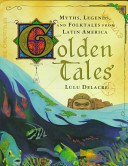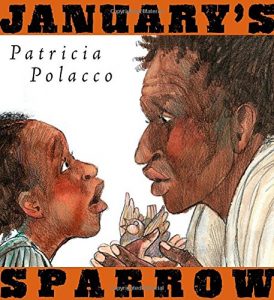
Twelve classic tales of Latin America celebrate the literature, culture, and history of thirteen countries, including Mexico, Puerto Rico, and Colombia. By the author of Arroz Con Leche.
Materials from the Americas

Twelve classic tales of Latin America celebrate the literature, culture, and history of thirteen countries, including Mexico, Puerto Rico, and Colombia. By the author of Arroz Con Leche.
 Patricia Polacco’s most powerful book since Pink and Say. In the middle of the night, The Crosswhites—including young Sadie—must flee the Kentucky plantation they work on. Dear January has been beaten and killed by the plantation master, and they fear who may be next. But Sadie must leave behind her most valuable possession, the wooden sparrow carved for her by January. Through the Underground Railroad, the Crosswhites make the slow and arduous journey to Marshall, Michigan, where they finally live in freedom. And there they stay, happily, until the day a mysterious package shows up on their doorsteps. It is January’s sparrow, with a note that reads, “I found you.” How the Crosswhites, and the whole town of Marshall, face this threat will leave readers empowered and enthralled. This is a Polacco adventure that will live in the minds of children for years.
Patricia Polacco’s most powerful book since Pink and Say. In the middle of the night, The Crosswhites—including young Sadie—must flee the Kentucky plantation they work on. Dear January has been beaten and killed by the plantation master, and they fear who may be next. But Sadie must leave behind her most valuable possession, the wooden sparrow carved for her by January. Through the Underground Railroad, the Crosswhites make the slow and arduous journey to Marshall, Michigan, where they finally live in freedom. And there they stay, happily, until the day a mysterious package shows up on their doorsteps. It is January’s sparrow, with a note that reads, “I found you.” How the Crosswhites, and the whole town of Marshall, face this threat will leave readers empowered and enthralled. This is a Polacco adventure that will live in the minds of children for years.
Skippyjon Jones, the Siamese cat that thinks he is a Chihuahua dog, has an adventure on Mars.
 When a guy in his class looks at him funny, Diego punches him in the face, and ends up on probation. At first he wants nothing to do with his probation officer. But as Diego starts to open up, he begins to realize that Mr. Vidas is the first person in his life who ever really wanted to listen to him. With Vidas’s help, Diego begins to make real progress in controlling his anger. He even opens up enough to tell Vidas about the shark tooth that his stepfather gave him that he uses to cut himself. But only if Diego can find the courage to trust Vidas with the darkest secrets from his past will he be able to heal completely. In this story of a boy trying to grow beyond a painful past, award-winning author Alex Sanchez calls upon his personal experience as a probation officer to reveal the complexities of one of his most genuinely realized characters to date.
When a guy in his class looks at him funny, Diego punches him in the face, and ends up on probation. At first he wants nothing to do with his probation officer. But as Diego starts to open up, he begins to realize that Mr. Vidas is the first person in his life who ever really wanted to listen to him. With Vidas’s help, Diego begins to make real progress in controlling his anger. He even opens up enough to tell Vidas about the shark tooth that his stepfather gave him that he uses to cut himself. But only if Diego can find the courage to trust Vidas with the darkest secrets from his past will he be able to heal completely. In this story of a boy trying to grow beyond a painful past, award-winning author Alex Sanchez calls upon his personal experience as a probation officer to reveal the complexities of one of his most genuinely realized characters to date.

Abuelita’s hair is the color of salt. Her face is as crinkled as a dried chile. She booms out words as wild as blossoms blooming. She stuffs her carcacha–her jalopy–with all the things she needs: a plumed snake, a castle, a skeleton, and more. Her grandson knows he has the most amazing grandmother ever–with a very important job. With her booming voice and wonderful props, Abuelita is a storyteller. Next to being a grandmother, that may be the most important job of all. Sprinkled with Spanish and infused with love, My Abuelita is a glorious celebration of family, imagination, and the power of story.
See the review in WOW Review, Volume 4, Issue 1.
 Yum! Yum! A delicious beany, cheesy smell wakes up Mouse. He follows his nose down the street to a Cinco de Mayo festival. There, high in a tree, he spies a magnifica pinata. If only Mouse could get just one piece of candy from it. But danger is everywhere, from the stomping feet of dancers to Cat, who is planning a holiday fiesta of his own with Mouse on the menu.
Yum! Yum! A delicious beany, cheesy smell wakes up Mouse. He follows his nose down the street to a Cinco de Mayo festival. There, high in a tree, he spies a magnifica pinata. If only Mouse could get just one piece of candy from it. But danger is everywhere, from the stomping feet of dancers to Cat, who is planning a holiday fiesta of his own with Mouse on the menu.

In a series of poetic sentences, a young boy (biracial Mexican/Caucasian) tells about some of the everyday things for which he is thankful. Come share the joy, and think about all the things for which you can say, ¡Gracias! Thanks!
 Finally! After begging their parents for ballet lessons, Ivy and Bean finally get what they want…well, not exactly. Much to their surprise, it turns out ballet lessons do not include karate chops and roundhouse kicks to the villain’s heart. The girls have no interest in learning how to dance gracefully, but they promised their parents they would finish the entire ballet course! When it comes time for Ivy and Bean to participate in the ocean-themed class recital, the girls must figure out a way to get out of it without breaking their promises.
Finally! After begging their parents for ballet lessons, Ivy and Bean finally get what they want…well, not exactly. Much to their surprise, it turns out ballet lessons do not include karate chops and roundhouse kicks to the villain’s heart. The girls have no interest in learning how to dance gracefully, but they promised their parents they would finish the entire ballet course! When it comes time for Ivy and Bean to participate in the ocean-themed class recital, the girls must figure out a way to get out of it without breaking their promises.